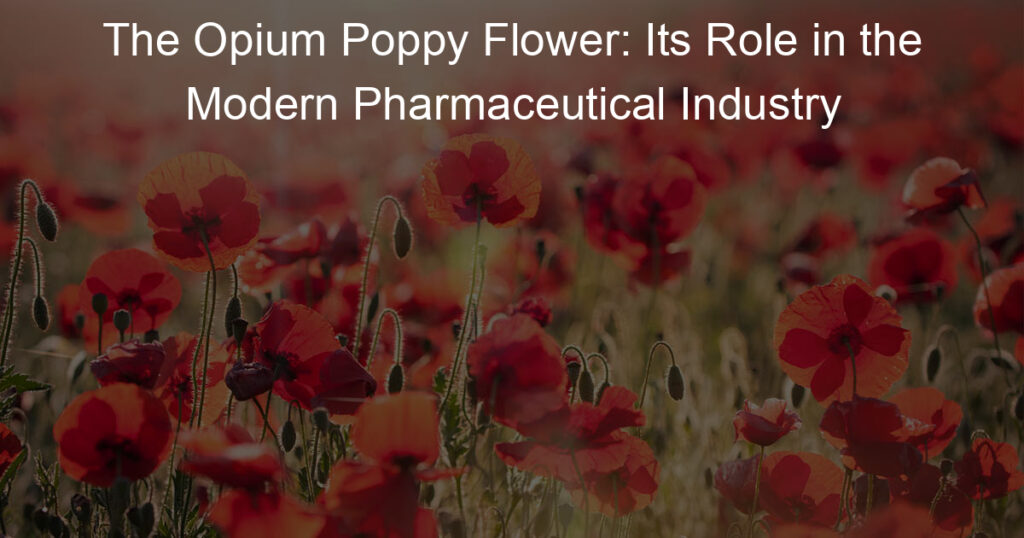When you think of the opium poppy flower, images of black market trades and shady drug dealers might come to mind. But what many people don’t realize is that this small but powerful bloom has played an extraordinarily important role in modern medicine, acting as a key component in numerous prescription medications available today — from heroin-based painkillers to cough-suppressing syrups.
What are the opium poppy and its role in medicine?
The opium poppy, or Papaver somniferum, is a plant species used to produce both opium and its derivatives. This plant has been an integral part of medicine for centuries: Ancient Greek physicians including Hippocrates used the morphine produced by this species for pain relief, while in modern times, drugs like codeine and oxycodone were developed from morphine.
The opium poppy can be found growing wild all over the world, though some countries (like India and Turkey) cultivate it on a large scale for medical use. Despite its controversial reputation, it’s undeniable that the opium poppy remains a critical part of the medical landscape today—without it, relieving certain types of pain would be much more difficult.
What are some opium-derived pharmaceuticals?
Opium is a plant with a rich history of use in medicine, making its way into traditional medical treatments centuries ago. Today, the derivatives of opium still play an important role in modern pharmaceuticals.
Morphine and codeine are two classic examples; they are both alkaloids derived from opium and they are used to help manage pain when taken orally or via injection. Then there’s the ravine, which is found in many medicines used to treat drug addiction. Hydrocodone and oxycodone are two more opiates that are frequently prescribed for strong pain relief.
While opium-based pharmaceuticals often have useful applications, it’s important to remember not to take them without consulting your doctor first — they can be very addictive and dangerous if abused.
What are the drawbacks of opium-derived medicines?
Opium-derived medicines have often been used to treat many types of illnesses, but they bring a range of drawbacks that should be considered. These medicines are often highly addictive and can cause serious physical, psychological, and social problems if not used responsibly.
They can also have negative effects on the user’s immune system, impair judgment, and lead to long-term dependency issues. Furthermore, due to the high cost associated with the production of these drugs and their availability varying greatly from country to country, access is typically difficult and limited for many people.
Ultimately, although opium-derived medicines may provide relief from certain ailments in the short term, their potential for long-term harm should not be underestimated.
How is opium poppy cultivation regulated globally?
Cultivating opium poppy varies from country to country, as not all countries tolerate the growth of illegal crops. In some nations, such as India and Slovakia for example, certain areas are designated for poppy cultivation by government regulation and thus acknowledged in a very limited capacity.
Other countries, like Burma and Afghanistan, suffer greatly with opium poppy production having been taken over by criminal forces who use its cultivation to finance operations. The UNODC (United Nations Office on Drugs and Crime) helps to regulate international drug control policies which aim to decrease and ultimately eradicate illicit crop cultivation.
This includes restricting the areas in which it is legal and possible to grow opium poppy – through proper education and enforcement – as well as helping farmers switch over to alternative crops which provide equal or better economic benefits for their families.
What is the history of opium use in medicine and society?
The history of opium use in medicine and society goes back centuries and it’s one with a bit of a sordid past. Opium has been utilized as a painkiller since ancient times, but its addictive potential began to be noticed in the 19th century.
This had led to the restriction of its usage over time, and it is now heavily regulated in most countries. Despite that, it still plays an important role in modern medical treatments and can be beneficial to certain people, when used responsibly and as part of a doctor-prescribed regimen.
Of course, that also means we have to be extra mindful about this powerful substance given its capacity for addiction: without proper monitoring, we could once again find ourselves where we were centuries ago – battling reckless opium use and all the damage it caused!
How is opium production different from illegal drugs?
The production, distribution, and use of opium are widely regulated compared to illegal drugs. It is primarily produced legally, which allows the government to monitor, distribute and set quotas on its production.
Opium production also typically happens in highly monitored factories or laboratories where safety protocols and overseen by trained professionals. In contrast, illegal drugs are often produced in less sterile environments with little to no supervision or regulation.
Their distribution networks are also much more loosely established due to the lack of legal oversight. As a result, there is less reliability in terms of potency and purity compared to products created with legitimate opium production practices. Long story short, while both opium and illegal drugs present significant risks they are still vastly different due to the legalized nature of opium production.
Conclusion
Pharmaceuticals have come a long way in providing relief to many of us and the opium poppy flower is in part responsible for that progress. While it might be easy to point out its negative effects, we should also remember that it has incredible medicinal value as well. With further research and regulation, the opium poppy flower can continue to provide valuable solutions for dealing with human ailments moving forward.














